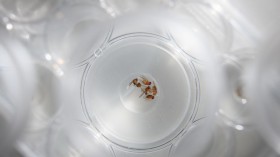Locals in Central Oregon were drawn to a peculiar predator insect, known as a robber fly, as residents are watching with interest, concern, and curiosity.
Pete Pederson, an Oregon Bee Atlas and OSU Extension volunteer, explained that the species of fly is a predator, which makes it very different from most other flies.
This predator is known as the Robber fly, and it is built for speed.
Pederson called the robber fly the top gun when it comes to flight. He explained that the robber fly has to take off, grab the prey insect, and once it grabs it, the prey won't be able to get away.
Spines on its legs and spines all over its body help in taking hold of its prey.
This fly is deadly to other insects for a variety of reasons, including its quickness.
According to Pederson, the insect has a beak that emerges from its bottom, which is where the neurotoxins are delivered and from which the insect can later suckle its material.
The high desert is not an exception to the presence of these predators, which have been around for countless tens of thousands of years.
Been There the Whole Time
Lisa Cowan, the Administrative Natural Resources Assistant at OSU extension, said that she noticed a robber fly and a honey bee while out for a lunchtime stroll by some bushes, and it immediately caught her attention.
This is because while she frequently observes robber flies flying around, she has never witnessed them with prey.
Of course, these flies also hunt other insects like flies, wasps, butterflies, dragonflies, and even spiders in addition to bees.
Robber flies, according to insect enthusiast Pederson, don't appear to be a contributing factor in the decline of the bee population. He has never heard of any studies showing that robber flies have any effect on honey bees or native bees.
A local supplier of bee products made another comment regarding robber flies and their potential impact on the bee population.
He claimed that he has never even heard of these flies and that he doesn't think they've had much of an effect on his bees.
Robber flies rarely bite humans, but they are capable of doing so.
According to Pederson, it occasionally happens that there are so many eyes on something that no one has ever noticed it before. As a result, they are startled to see something new when they have actually been here the entire time, Central Oregon, Daily News reported.
Read also: Study Showed that Flying Insect Population Decreased by 60% Since 2004
Robber Flies
The diverse group of predatory flies known as robber flies typically perches in an open space, swivels its head to look around, and then flits out to hunt for insect prey.
The majority have spiny legs, a long, tapered abdomen, and typically rest with their wings folded down the back.
The mouthpieces are a sharp knife-like proboscis for injecting saliva into prey, and the face frequently has a beard. The head is depressed, and in that small valley between the two large compound eyes are three tiny eyes (ocelli).
Many have a distinct buzzing or rattling sound while flying.
Larvae, which resemble grubs, are found in or on soil, in rotting woodm, or decaying objects.
Related article: Insect Predators May Protect Us from Infectious Diseases
© 2024 NatureWorldNews.com All rights reserved. Do not reproduce without permission.





